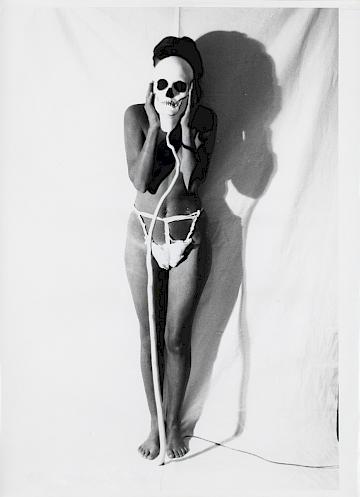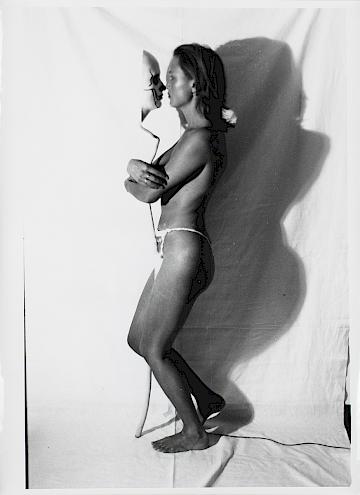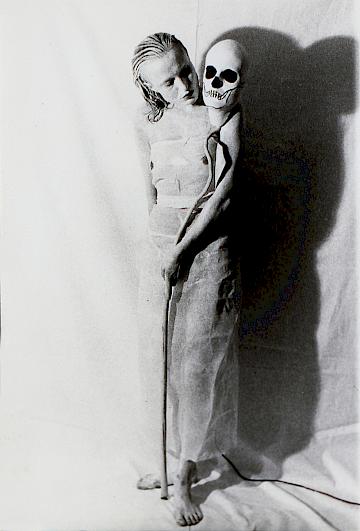Birgit Jürgenssen's Dances
In her photographic and graphic works from the 1970s Birgit Jürgenssen often pursued strategies of clownery and the clownesque. Employing decidedly feminist imagery and the techniques of irony and parody, she focussed mainly on gender relations and the conventions of representing femininity. In many cases she also commented upon and transformed the iconography, the particular masquerade, above all of the lady and housewife in postwar Austria. In 1979 and 1980, however, she also produced a number of photographic series which placed masks and mask-like qualities in an archaic context and reverberated within the echo chamber of folk culture as well as – for example in Totentanz mit Mädchen (ph1340) (Danse Macabre with Maiden – 1979/80; b/w photographs, each 40 x 30 cm) – that of medieval and early modern images. In Danse Macabre with Maiden a concept of mask is used which naturally first constitutes personhood in its fleetingness and thus precedes the critical modes of representation of mask-like femininity, of femininity as a masquerade, even though the encounter between the maiden and the personification of death belongs – as the most vivid construction of an antithesis – to the realm of gender metaphysics. It is a mask which can be put on or taken off, which serves as a personal opposite (ph1334)
(Danse Macabre with Maiden – 1979/80; b/w photographs, each 40 x 30 cm) – that of medieval and early modern images. In Danse Macabre with Maiden a concept of mask is used which naturally first constitutes personhood in its fleetingness and thus precedes the critical modes of representation of mask-like femininity, of femininity as a masquerade, even though the encounter between the maiden and the personification of death belongs – as the most vivid construction of an antithesis – to the realm of gender metaphysics. It is a mask which can be put on or taken off, which serves as a personal opposite (ph1334) and also as a form of concealment; it is a mask that is entrusted to and caressed by its bearer, and one to which Birgit Jürgenssen also clings (ph4)
and also as a form of concealment; it is a mask that is entrusted to and caressed by its bearer, and one to which Birgit Jürgenssen also clings (ph4) . As the respective third party, the monstrous shadow synthesizes in its disembodiment the confrontation between the naked or dressed – viz. draped with cloths – maiden and the mask of death (ph7)
. As the respective third party, the monstrous shadow synthesizes in its disembodiment the confrontation between the naked or dressed – viz. draped with cloths – maiden and the mask of death (ph7) . However, all three appear on a vertically hung piece of white linen, a shroud, and together they form a vera icon, suggested above all by the draping of the cloth.
. However, all three appear on a vertically hung piece of white linen, a shroud, and together they form a vera icon, suggested above all by the draping of the cloth.
As ambiguous images fluctuating on the one hand between horizontality – in the allusion to the deathbed – and verticality, and on the other in terms of the deliberate shadow effects, the photographs allude to a correlation between the laying out of a corpse and image formation, between loss and recovery – origin myths in the art of portraiture. mehr
Whereas in the early 16th century the encounter between death and the maiden is often depicted as an unlawful act, as robbery, for example in the work of Hans Baldung Grien, where death is variously depicted as a dark and sinister or skeletal form approaching the near-naked, fair-skinned maiden from behind, grabbing her by her long hair and trying to forcibly pull her around, kiss her and drag her off, here it is the maiden who holds death in her arms and consents to the encounter. She does not seem to be saying: “Pass by, oh pass by! Leave me, cruel skeleton! I am still young, go, dear Death! Do not touch me!” Instead she already seems to believe in the words of Death: “Give me your hand, you lovely, tender creature! I am a friend and I don’t come to punish. Be of good mind, I am not wild, You will sleep softly in my arms!”
Death and the Maiden – in the exclusivity of the individual encounter – is here entwined with thedanse macabre, the scenic element of which in late medieval paintings and prints was often broken down into a series of figures, with each skeleton taking the hand of one of the living – who were often arranged according to their social rank.
Birgit Jürgenssen turns this dance into a series of photographs, where in changing poses or forms of encounter an intimate relationship between two people, a scenario of mutual seduction, is presented.
In Danse Macabre, Birgit Jürgenssen, who is present in almost all of the images in her photographic oeuvre, yet without evoking a connection to portraiture that would go beyond personhood in terms of wearing a mask (similar to Cindy Sherman’s work, many of her photographs therefore show the remote shutter release cable as the centre of the staging), assumes control over the encounter. It is therefore not a male gaze which defines the maiden as one of the two Others – at least in so far as it is possible to escape the constitution of identity through the gaze of the Other; Birgit Jürgenssen fills the role of the maiden, appropriates it, and thus causes the constructed opposite to collapse. What catches the eye instead are alignments: alignments of a white face and a white skull-mask; of the backbone and the baton which enables the mask to be carried in front of the body, as may have been seen in medieval processions; of the length of the two bodies; in some pictures also the parallel arrangement of painted nipples shining through a transparent cloth; of the black eyeholes of the mask; above all, however, the merging of shadows.
In performing her round dance with the mask of death, which does not appear as a dangerous revenant, Birgit Jürgenssen ‘dances’ naked in some of the photographs, while in others she wears various garments and cloths. Simple, draped cloths – in one instance a shirt – recall the motif of the theft of the shroud as final testimony of having fallen under the spell of death. It is no accident that these photographs are in black and white: the non-colours not only enable opposites to be driven apart, they also allow maximum convergence in the shades of grey. In addition, they open up that quasi-mythical or archaic space which Jürgenssen was working towards in other series during this period; it is a space which was evoked by the surrealists – above all in relation to contemporary ethnography, the aesthetic concepts and methods of which Birgit Jürgenssen herself supports, but it is also a space in which Elfriede Jelinek recently performed with her Princess Plays:Death and the Maiden.
Following a Barthesian understanding of myth, in Jelinek’s works the enchanted princesses we know from fairy tales – the beautiful Snow White, whose search for truth behind the seven mountains ends with her being chased, killed and placed in a glass coffin, or Sleeping Beauty, imprisoned by sleep as she waits to be kissed awake by a prince (and for what? – That is the question: “Which country do you plan to rule? I bet it’s mine”) – get just as much chance to speak as do Jackie (Kennedy) in her rivalry with Marilyn Monroe, or Sylvia (Plath) and Inge (Bachmann), who rack their brains along Marlen Haushofer’s Wall when it comes to claiming a feminine language, a feminine authorship, and also being visible within it. In playing this mythical space, however, Jürgenssen and Jelinek employ opposite means: while the latter, as heir to Patricia Highsmith and her Little Tales of Misogyny (1977), sarcastically exaggerates a quasi-male gaze, Jürgenssen modifies the theme of the picture from a feminine perspective.
In selecting four photographs from this series and adapting the format for the publication of her catalogue Früher oder später, Birgit Jürgenssen has related Danse Macabre with Maiden to the contemporaneous series Untitled (ph1423-ph1427) (1979; b/w photographs, each 23 x 18 cm), where her body is wrapped in a burlesque body mask. Here, in contrast to Danse Macabre, a real fight seems to be taking place – what seem to be two people confined inside one mask, a situation of playful distress; the head and upper body are merged into a bag; the childishly painted tokens of female genitals converge into a face. Together with the cloth-like legs of the body mask they form a four-legged female shape – mask and doll, animal and human being are combined: how many people fit behind a mask? How many masks can one person w(b)ear? And what is the difference between a mask, a face and a body?
(1979; b/w photographs, each 23 x 18 cm), where her body is wrapped in a burlesque body mask. Here, in contrast to Danse Macabre, a real fight seems to be taking place – what seem to be two people confined inside one mask, a situation of playful distress; the head and upper body are merged into a bag; the childishly painted tokens of female genitals converge into a face. Together with the cloth-like legs of the body mask they form a four-legged female shape – mask and doll, animal and human being are combined: how many people fit behind a mask? How many masks can one person w(b)ear? And what is the difference between a mask, a face and a body?
The alternation of front and rear views in the rows of photographs – a scenic element – indicates a turning motion, a dance. The reversal of breasts and eyes, pudenda and mouth, as well as the reference to the material, corporeal presence of menstruation in Danse Macabre, are all elements of foolish, carnevalesque activities, which – following Bakhtine – highlight the qualities of such festivities in the sense of being a productive reversal of societal order, a form of counter-cultural laughter which is in no way scared to tackle the subject of death.